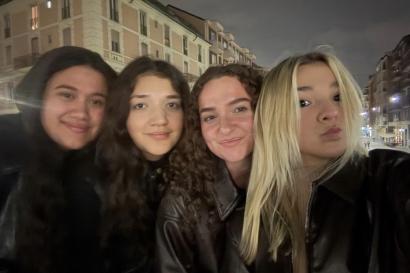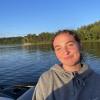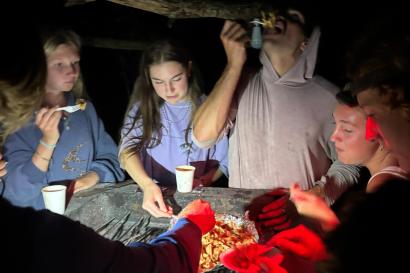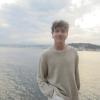Note: This post is from a week ago, due to problems finding internet. I am actually home from Ecuador now! But please enjoy this blog anyway.
Today I went SCUBA diving at Leon Dormido, an eroded tuff cone sticking out of the ocean about a mile offshore. Based on my previous dive here a couple weeks ago, I compiled a list of goals:
- 1. Don’t vomit from seasickness.
- 2. Don’t cry from fear before, during, or after the dive.
- 3. Don’t be the first diver to run low on air.
These were all the case last time, and I was determined to have a better experience.

Leon Dormido means “Sleeping Lion.”
On the way, I saw a flock of Galapagos shearwaters and brown noddys swarming the surface. Blue-footed and Nazca boobies flew by in pairs. We passed the frigatebird rookery and saw both magnificent and great frigatebirds and their white puffball babies. (The frigatebirds moved out here to an isolated beach after the National Park built lookouts to their previous nesting grounds.) One of the Spanish tourists on board lost his baseball cap in the wind and had to dive in after it, since leaving it would have been an illegal act of littering the Park.

A puffball baby frigatebird perches in Palo Santo branches.

A brown pelican feeds two gangly chicks from its pouch.
As I watched the horizon to prevent seasickness, I saw a black dorsal fin emerge from the water. Suddenly, a pod of a hundred bottlenose dolphins surrounded us! Six of the sleek mammals glided inches below the bow. Others leapt out of the water in powerful arcs. One dolphin kept landing with a harder-than-necessary splash, getting us all wet. It seemed like she was splashing us on purpose. When we stopped shrieking with excitement, we could hear the faint squeaks of the dolphins’ underwater conversations.
[If the video does not load, try this link: http://www.youtube.com/watch?v=Hf_V1cvrjwo]
How amazing is it that these animals live, comfortably at home, in the frigid Pacific Ocean? Dolphins aren’t crustaceans or fish or some other alien creature – they’re mammals, as closely related to us as dogs and cats. When I sit in my cozy bed or a brightly lit classroom, it’s mind-boggling to remember that the dolphins are still out there, eating or swimming or squeaking or splashing tourists, going about their dolphiny business.

The narrow channel at Leon Dormido.
When we arrived to Leon Dormido, we submerged right away. I spotted rainbow and spinster wrasse picking algae off the wall and a slow-swimming, knobby streamer hogfish that reminded of a mafia gangster. The most striking feature of the wall was its population of pencil-spined urchins. Each urchin nestled into a pockmark of its own creation in the hard lava wall, like a thorny queen in a throne. A layer of algal fuzz coated each thick spine. We even found a small urchin attached to the back of a green sea turtle’s shell.
[If the video does not load, try this link: http://www.youtube.com/watch?v=QCimiXY7qLg]
We descended along the sheer wall and settled on the channel’s sandy bottom. Spindly, chartreuse corals swayed in the current. Semicircular orange fan-corals stuck out at right angles from the wall, like shelf-fungi in the temperate rainforest. A school of ten Galápagos sharks appeared; the green gloom from which they emerged gave the illusion that we might have been surrounded by hundreds.

Here we are kneeling on the sandy bottom. From left to right: Nina, Amanda, Molly, April.
The first dive ended as quickly as it started, when the first divers ran low on air (not me, Goal #3 accomplished!) This was the first dive of my life in which I was not miserable and anxious (I accomplished Goal #2, don’t cry), and the lack of choppy waves made vomiting avoidable as well (Goal #1). We took an hour-long break onboard to eat Galak cookies and allow some condensed nitrogen to leave our blood.
During our second dive, we passed through a narrow section with such strong current, I needed to hold onto the wall just to stay in one place. A luminescent, swimming-pool-bottom-blue sponge coated the walls. I noticed tiny Galápagos blue-lined nudibranchs and a foot-long magnificent scallop.

Puerto Grande, as seen from the boat.
After our second successful dive, we boated to Puerto Grande for a delicious lunch of albacore, white rice, and mashed potatoes. A pair of tame lava gulls and a flock of nocturnal, squid-hunting swallow tailed gulls harassed us for scraps. I brought out my frisbee for a competitive game of toss with our dive instructor, Joselo, but there is a price for playing frisbee on a volcanic beach…

My toenail became part of the sand, just like thousands of urchin spines and coral fragments before it. My toe started to ache on the boat-ride home, but a ceiling of backlit Stratus fractus clouds, a wall of impending garúa mist, and a golden sunset filled me with peace. A little blood lost is an easy price to pay for such a magnificent day.
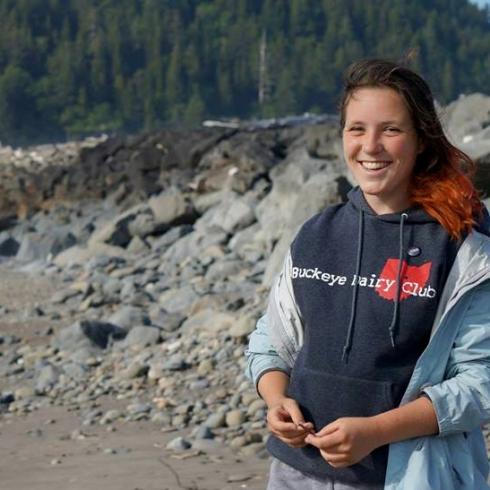
Nina Finley
<p><span style="color: rgb(29, 29, 29); font-family: Arial, Verdana, sans-serif; font-size: 12px; line-height: normal; background-color: rgb(237, 237, 237);">Nina Finley is a sophomore at The Ohio State University. She ventured to the Midwest from her hometown of Seattle, Washington to major in Animal Sciences and Evolution & Ecology. She would like to become a livestock vet or marine biologist. When she’s not studying, Nina loves to play ultimate frisbee, watch birds and raise meat rabbits. She’s passionate about agriculture, nature and Spanish, all of which she hopes to explore in Ecuador. Join the journey as Nina traces Darwin’s path and explores the natural wonders of the Galapagos Islands!</span></p>



